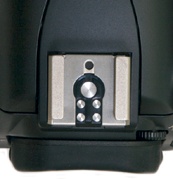Using an External Flash
On the top of the camera sits a hotshoe, a fairly standard camera interface that allows you to use a number of different accessories. It's called a hotshoe because it's an interface that provides electrical contacts through which the camera can communicate with an attached accessory (as opposed to a coldshoe, which has the same type of mount but provides no communication between the camera body and whatever is in the shoe).

Figure 10-7. You can attach an external flash to the hotshoe on the top of the camera.
You can use the hotshoe to attach special wireless or wired remotes, levels (for ensuring your camera isn't tilted), umbrellas to keep your camera dry, and other specialized accessories. But hotshoes are most commonly used for external flash units.
Even though the XS has a built-in flash, there are a number of reasons to use an external flash. They're more powerful, so they can cover a longer range and offer more latitude for exposure adjustment. Flash units all provide a specification called a guide number that indicates how powerful the flash unit is. For example, on Learning to See Again of the Rebel XS's instruction manual, you'll find a listing for Guide Number: 13/43 (ISO 100, in meters/feet). This number represents a constant that you can use to determine the range of the flash at a given aperture. For example, a guide number of 43 indicates that ...
Get The Canon EOS Digital Rebel XS/1000D Companion now with the O’Reilly learning platform.
O’Reilly members experience books, live events, courses curated by job role, and more from O’Reilly and nearly 200 top publishers.

